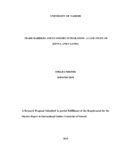| dc.description.abstract | The exchange of capital, goods and services across international borders or territories is
known as international trade. This study focused particularly on the bilateral trade
between Kenya and Uganda and the effects that certain barriers to trade have on the
countries’ economic integration. The study aimed at examining the effects of trade
barriers on economy integration between Kenya and Uganda. A descriptive survey was
conducted to collect detailed description of the existing status in Uganda. This was both
qualitative and quantitative data collection. The research design was appropriate because
of its purpose and objective, which was to collect detailed description of the existing
status with the intention of employing data to improve the current conditions. The study
involved the Uganda Embassy, Ministry of Foreign Trade and traders of both Kenyan and
Ugandan nationality. For consistence it focused on relative individuals under common
areas named. The study concludes trade barriers affected economic integration between
Kenya and Uganda. The study concludes that a large trade potential exists between
Kenya and Uganda and that trade liberalization through regional cooperation initiatives
will enhance the realization of this potential. More appropriate trade policies are needed.
While policies are being considered, and to some extent implemented, emphasis should
be given to the elimination of trade obstacles, such as nontariff and institutional barriers,
which increase transaction costs for importers and exporters. The study also concludes
that there is need for support coordinated regulatory reforms and setting up of regional
regulatory institutions as countries invest in regional infrastructure and liberalize trade in
services. The objective of maximizing revenue collection through high tariffs is
sometimes considered by governments in a short-term perspective and overrides other
important criteria, such as efficiency in production through increased trade. The study
recommends that infrastructure investments need to be complemented with trade
facilitation measures for intra-regional trade to easily move across borders. Reducing
bureaucratic requirements, streaming border management procedures and implementing
trade facilitation measures will reduce border crossing times. Own reforms will be
required to harmonize and reform transport-related standards and policies affecting trade
and, eliminate obstacles to the free movement of goods and services including service
providers. The study also recommends that Uganda and Kenya should provide technical
assistance to the industries and it should be provided free. It also recommends that
governments should serve as a check on one another so that Kenya and Uganda
commitment is seen as more credible than a national commitment. The focus on regional
infrastructure development will further boost regional trade, investment and integration
and make the region economically competitive. | en_US |



